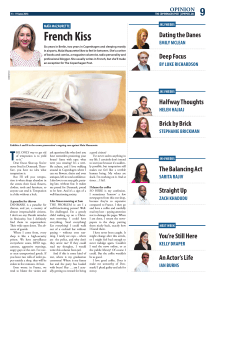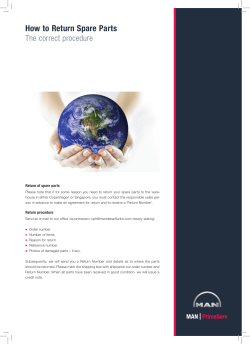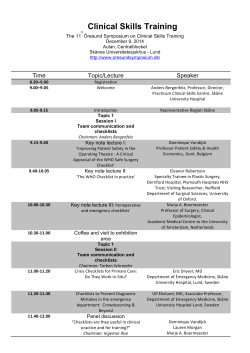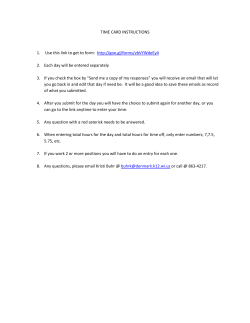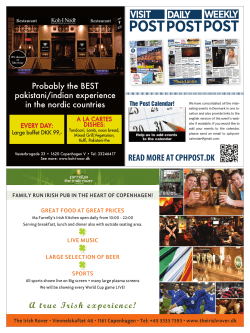
ROAD TRAVEL REPORT: DENMARK
ROAD TRAVEL REPORT: DENMARK (INCLUDING GREENLAND AND THE FAROE ISLANDS) KNOW BEFORE YOU GO… High quality expressways, highways, and secondary roads connect all areas of the country. Urban and rural road conditions are excellent. Cycling is very popular. Cyclists often have right of way over vehicular traffic. Be alert for cyclists when driving. Check cycle lanes before turning right. There were 431 road fatalities in 2001, a 13.5% decrease over the number that occurred in 2000. Denmark’s road safety record is comparable to that of the United States. There are 9.22 fatalities per billion vehicle kilometers traveled, compared to 9.4 in the US. ROAD REALITIES DRIVER BEHAVIORS GENERAL ROAD CONDITIONS Denmark’s strong commitment to road safety has reduced total annual fatalities and injuries in road crashes by over 50%. There are 1,650 km of national roads in Denmark, 870 km of which are motorways. These national roads handle 23% of all of Denmark’s road transport. In non-emergency situations drivers often flash headlights, rather than sounding the horns to warn other drivers. About 85% of all road crashes involve one or more of the following factors: driving while intoxicated, speeding, cyclists, and/or traffic flow at junctions. National, regional, local and private community roads have uniform standards for road width, intersections, markings, speed-reducing measures and temporary closures. High quality expressways, highways, and secondary roads connect all areas of the country. Roundabouts (traffic circles) and speed bumps are common. Most roads are well sign-posted. All driving signs are international. Some common road signs: Almost 50% of road crashes occur at junctions. Speeding and/or failure to yield right-of-way are common factors in these road crashes. Alcohol is involved in about 25% of fatal road crashes. In urban areas, many cyclists speed, ignore red lights, fail to signal when turning, and ride on the pavement rather than staying in cycle lanes. Ensrettet Korsel One-way Street Fare Danger Fodgaengerovergang Pedestrian Crossing Gennemkorsel Forbudt No Through Road Farligt Sving Dangerous Bend Hold till Hojre Keep to the Right Hold till Venstre Keep to the Left (Continued on next page.) Many cyclists fail to show respect for fellow road users, including other cyclists. At busy intersections, some cyclists try to pull out ahead of fellow cyclists. ROAD TRAVEL REPORT: DENMARK 1 © ASIRT 2004 Some common road signs (continued): Farligt Sving Hold till Hojre Hold till Venstre Indkorsel Forbudt Korsvej Omkorsel Parkering Forbudt Vejen er Spaerret Dangerous Bend Keep to the Right Keep to the Left No Entry Crossroads Diversion No Parking Road Closed The Øresund Fixed Link, a 16-kilometre-long combined bridge for motor vehicles and tunnel for trains, connects Copenhagen with Malmö in Sweden. The Storebælt Link is a combined four-lane motorway and dual-track railway between Halsskov on Zealand Island and Knudshoved on Fyn Island. Bicycles and mopeds are not permitted to use it, but a shuttle service is provided. The service is not 24-hour. Road Conditions in Greenland and the Faeroe Islands: Bicycle lanes are usually located by the curb. Be alert for traffic in these lanes. o The Marguerite Route is a 3,500 km tourist route marked by “daisy” signs. The route is not recommended for cars pulling a trailer or camper as some roads included in it are very narrow and winding. There is no established road or railway system in Greenland. Local travel is by foot, skies, snowmobile, dogsled, boat or air. o The largest of the Faroe Islands have roads, but most local travel is by foot, horseback, boat or air. Denmark has five E-roads (international roads that link European nations): The E20, E39, E45, E47, and E55. Highway E 20 (crosses Denmark from west to east) runs from Esbjerg, 200 km west of Copenhagen. It crosses the E 47 from Germany and runs to the island of Funen. Highway E 47 runs from Rødby, which is 150 km south of Copenhagen. Ferry connections to Germany are available to and from Germany there. E 47 continues on to Elsinore, which is 47 km north of Copenhagen. Ferry connections to and from Sweden are available. The Great Belt Bridge connects Zealand, the island on which Copenhagen is located, with the Funen region of Denmark and the rest of continental Europe. This system of bridges and a long underwater tunnel provides a passage way for both rail and road traffic. URBAN TRAVEL Traffic is manageable even in major cities. The condition and maintenance of urban streets and roads is excellent. Street parking is often restricted to one hour. Illegally parked cars may be impounded. Parking meters in larger cities generally take discs; obtain parking discs at tourist offices or gas stations. The risk of being involved in a road crash is three times higher in urban areas than on motorways or on primary rural roads. Vulnerable road users (pedestrians, cyclists, etc.) are involved in 80% of road crashes in urban areas. CITY PROBLEMS USEFUL INFORMATION COPENHAGEN Traffic is congested only during the week day rush hour. Is the main center for transport to other regions in Denmark. Some bridges may be low. Be careful when traveling in tall vehicles. Has an extensive public transport system. Finding addresses: Even numbers are on one side of the street, and odd numbers are on the other side. Street numbers may have an A, B, or C inserted after them. Buses are well maintained and inexpensive to ride. For information on bus transportation, call 36-45-45-45 anytime. (Continued on next page.) ROAD TRAVEL REPORT: DENMARK 2 © ASIRT 2004 CITY PROBLEMS USEFUL INFORMATION COPENHAGEN (CONTINUED) Indre By, the oldest section of the city, is a maze of squares, alleyways, and old streets. Copenhagen and North Zealand Transport buses, State Railway, and S-tog trains (Subway) operate on a joint zone fare system, allowing a transfer from train to bus and back with one ticket. Private train routes within a 25-mile radius of the city may honor these transfers. Parking restrictions: Must pay to park in the city center. In Ydre Østerbro, Indre Østerbro, Ydre Nørrebro, Indre Nørrebro, Vesterbro, Islands Brygge and Sundby Nord: On work days from 8am to 7pm, free parking is limited to 2 hours. Additional 2-hour or day tickets may be purchased. Taxis can be hailed. If the yellow “Taxa” light is lit, the taxi is available. Cycle taxis provide tours of the city. There are numerous pedestrian-only streets. Strøget, is the longest uninterrupted pedestrian-only street in Europe. Exploring the central part of the city on foot is recommended. City parking lots are readily available and are often open 24-hours. Parking is permitted in marked areas only. Illegally parked cars may be towed. Parking fines are especially heavy in the city center. Free parking spaces are available in parking garages along major roads into the city. For more info on parking, see www.parking.kk.dk/Pguide/Engelskpguide.pdf. Bicycles are extremely popular. Cycle lanes are available on many streets. There is an extensive system of cycle lanes into the city center. Free “City Bikes” can be used to tour central Copenhagen between May 1st and December 15th For more info, see www.bybklen.dk. Kastrup Airport is located 7.25 miles from central Copenhagen. Air-rail trains link the airport with the city’s Central Railway Station. SAS buses, local buses and taxis are also available. The S-tog provides connections from central Copenhagen to suburbs. A Eurail pass generally allows travelers to ride the S-tog free of charge. Ph: 33-14-17-01. ODENSE Driving is generally difficult only during rush hour. Much of the city has been pedestrianized. Walking to destinations is recommended. Traffic calming schemes on many streets lowered speeds to 45, 30 or 15 km/h. Bicycle paths are abundant. Cycle paths are inspected and repaired regularly. Snow clearance of bike paths is given equal priority with clearing the roads. (Continued on next page.) ROAD TRAVEL REPORT: DENMARK 3 © ASIRT 2004 CITY PROBLEMS USEFUL INFORMATION ODENSE (CONTINUED) The city has over 2000 bicycle-only parking spaces. ARHUS A key trade and transport center. Easily reached by train or ferry. There is an underground bicycle parking lot at Odense Central Station. Buses are the primary means of public transport. The city center is very compact; easily toured on foot. RURAL TRAVEL SEASONAL TRAVEL The condition and maintenance of rural roads is excellent. The risk of being involved in a road crash is much lower on rural roads, but the severity of rural road crashes tends to be much higher than urban road crashes. Winter months tend to be wet and accompanied by long periods of frost. Winter extends from December to March. February is the coldest month. Arctic weather conditions in winter may cause delays and interruptions in transport services. The Storebælt Bridge is sometimes closed to caravans, trucks and other high-sided vehicles due to high winds. All other cars must restrict speed to 80 km/h or less. The largest of the Faroe Islands have roads, but most local travel is by foot, horseback, boat or air. In the Faroe Islands, be alert for sheep. They are easily startled and may leap out in front of your vehicle. If you hit one, contact the police in Tórshavn at Ph: 311448 for assistance. PEDESTRIAN TRAVEL Watch for traffic in both bicycle and normal traffic lanes when crossing streets. Pedestrians are required to yield to bicyclists. POLICE ENFORCEMENT Fines for speeding or other driving infringements must be paid on the spot. Failure to pay may result in impoundment of the vehicle. Speed laws are strictly enforced and heavy fines are imposed. DWI offenses can result in high fines, loss of license, and/or imprisonment. If installed, seat belts are required for the driver and all front seat passengers over 3 years of age. Children under 3 must be in a child safety seat if riding in the front. Children 3-7 riding in the back must use a child safety seat or booster cushion. Use of a handheld cell phone while driving is prohibited. Vehicles and motorcycles are required to use low beams when driving, even during the day. ROAD REGULATIONS Traffic drives on the right and passes on the left only. A valid U.S. driving license may be used in Denmark. If license is lost abroad, have a police report issued and contact home state DMV to obtain a faxed confirmation that you hold a valid license. Present faxed confirmation to a local Danish Driver’s License Office and ask for a temporary Tourist Driver’s Permit. The minimum driving age is 18. Green Card Insurance is required. Otherwise temporary insurance must be purchased at the border. ROAD TRAVEL REPORT: DENMARK 4 © ASIRT 2004 Turn signals must be used when changing lanes on motorways. Warning lights must be turned on to warn other drivers in the event of sudden danger on motorways. Studded tires are not required in winter. If used, they must be on all four tires and may be used only between November 1st and April 15th. Speed limits for cars: Built-up areas Major roads outside towns Motorways A few motorway sections 50 km/h (31 mph) 80 km/h (50 mph) 110 km/h (68 mph) 130 km/h (80 mph) Speed limits for Buses, trucks, and vehicles towing a trailer: Built-up areas Major roads outside towns Motorways 50 km/h (31 mph) 70 km/h (43 mph) 80 km/h (50 mph) Built-up areas are indicated by a white sign with a town silhouette on it. No passing zones are designated on some sections of Denmark’s motorways: No passing zones are generally 5-12 km long and are marked with warning signs. No passing zones apply to vehicles that are towing trailers, buses and trucks. Days and time period when passing is not allowed— Monday-Friday from 6am to 6pm. A blood alcohol level of 0.05 is strictly enforced. Driving under the influence of drugs or medications that negatively affect your ability to drive is illegal. A line of triangles, painted across the road, indicates one must yield to on-coming traffic. Drivers must yield to traffic approaching from the right and to buses pulling out from a bus stop. Drivers must yield to pedestrians in crosswalks, at intersections and in roundabouts. Drivers must yield to cyclists and mopeds traveling in their lane. When turning right, be alert for these vehicles coming up from behind. Parkering/Standsning/Stop Forbudt means no parking/no stopping, but you are allowed 3 minutes to load/unload in zones with these markings. Tires must have a minimum tread of 1.6 mm. Vehicle requirements: Emergency warning triangles. If you are towing a trailer, you must have suitable mirrors on each side of the towing vehicle. A First Aid Kit and fire extinguisher are recommended. On the Faroe Islands bus service is well developed. Blue, inter-city buses provide transport to most towns and villages. In Tórshavn, red local buses offer routes to most parts of the town. ROAD RECOMMENDATIONS TRANSPORTATION OPTIONS BUSES The safety of public transportation is good. Bus schedules are generally coordinated with train schedules. Bus routes often depart from train stations. Country buses operate where there are no trains. Bus service is sparse in the rural parts of Als and in Mon. Many drivers speak English. Be sure that the taxi is metered. Taxis that are available will have a fri (free) sign (a green light) turned on. TAXIS Buses that were registered after October 1999 are required to have seatbelts. If there are seatbelts, passengers are required to use them. ROAD TRAVEL REPORT: DENMARK 5 © ASIRT 2004 RENTAL CARS Rental cars are readily available. Reserving one prior to departure reduces costs. used only in the inner-city area. They must be returned to the place where they were picked up. Cycling in the Faroe Islands: Off-road cycling is prohibited. Roads are often steep; good brakes are a necessity. Avoid longer tunnels due to poor ventilation conditions. Some tunnels are narrow, making cycling hazardous. (Inter-city buses often accommodate bikes, providing an easy means of transit in hazardous areas.) Check with local tourist offices for current road conditions. National Cycle Routes in Denmark The minimum age for renting a car is 20. Some companies require a minimum age of 28. You must have a valid national driving license. Most agencies require foreign drivers to have an International Driving Permit. TRAINS Trains connect most cities, large and small, with Copenhagen. For information on train service when in Denmark, call #33-14-88-00. The Øresund Link provides train service between Denmark and Sweden. o The West Coast Route—Rudbøl to Skagen: 560 km (312 miles), of which 70% are paved. Wide tires are best as some stretches are gravel. Is a part of the North Sea Cycle Route. More info: http://www.northsea-cycle.com/index1.html o Hanstholm to Copenhagen: 420 km (218.7 miles), of which 80 % are paved. Gravel surface in one section. o Hærvejen (Historic Military Route)—Viborg to Padborg: 450 km (281 miles), of which 78% are paved. o Søndervig to Copenhagen: 310 km (190 miles), of which 90% are paved. Most of the route is along local roads. Runs through a more hilly section of Denmark. MOTORCYCLES & BICYCLES The flatness of the terrain and low traffic density on smaller roads make cycling a good touring option. Denmark is one of the safest countries for cyclists in Europe. There are bike lanes along streets of most city centers and extensive bike paths link towns throughout the country. Rental bikes are readily available. Motorcyclists must wear helmets when riding. o Bring your own helmet as helmets are not included with most bike rentals. The East Coast Route—Skagen to Sønderborg: 650 km (400 miles), of which 90 % are paved. o Esbjerg to Copenhagen: 330 km (205 miles), 92% are paved. Bike thefts are very common. Bicycles have the right-of-way over pedestrians and automobiles. Visitors should always be alert for bicycle paths. o Sjællands Odde (Spit of Sealand) to Gedser: 230 km (143.7 miles), of which 90% are paved. Well suited for families. Cycling is prohibited on motorways and certain major roads. o Motorcycles may be used to pull a trailer; mopeds may not. The South Sea Route—Rudbøl to Møn: 360 km (225 miles), of which 95% are paved. Mostly flat; some hilly stretches. Primarily covers secondary roads and cycle paths. A few roads have heavier traffic. More info: www.bikeandsea-denmark.com In Copenhagen and other cities, bicyclists should be alert for bus passengers and pedestrians stepping off the curb into the cyclists’ path. This is particularly common in Norregade, where cyclists are allowed to ride against the one-way traffic. o Helsingør (Elsinore) to Rødby: 250 km (157 miles), of which 92% are paved. Read more: www.bike-berlin-copenhagen.com o Tour of Bornholm: 105 km (65 miles), of which 90% are paved. o Limfjords Route: 610 km (381 miles), of which 90% are paved. Copenhagen has a free bike transport system. The bikes are available from May to December and can be ROAD TRAVEL REPORT: DENMARK 6 © ASIRT 2004 CRIME & SECURITY The crime rate is relatively low. Violent crimes are very rare. Petty crime is more of a problem in major cities. Car and home break-ins are increasing. Maps of Denmark, Greenland, and the Faroe Islands are available on: http://www.denmark.org/about_denmark/maps.html. There are no gasoline stations on motorways. A reserve supply of a maximum of ten liters of gas is permitted. Regular 92 (Blyfri Benzin), Unleaded Super 95/98 (Super Bensin), and Diesel are available. EMERGENCY INFORMATION TOURIST ASSISTANCE Emergency numbers for fire, police or ambulance: In Denmark and the Faroe Islands, #112. In Greenland, contact the local police. Rescue corps provides 24-hour help. Ph: 33 14 22 22. Emergency phones are located at 2 km intervals on motorways. Calls are forwarded directly to the police. Police can identify the location of each phone. Provides 24-hour coverage of emergencies. Trafikken The Traffic Information Center: Call 70-10-10-40 anytime to obtain traffic reports, reports on rush-hour traffic, the weather, road conditions, ferry schedules, road construction work areas and help with itinerary planning. Information is available for Denmark and other European nations. Email: trafikinformation@vd.dk. Most stores and public transportation are handicap accessible. For specific information relating to disabilities, contact the Scandinavian Tourist Board or the Disabled People’s User Service (Kloeverprisvej 10B, DK-2650 Hvidovre, København. Ph: 36-75-17-93. National automobile club: Forende Danske Motorjere. Ph: 45 93 0800. There are extensive facilities for tourism in Denmark. The prime season for tourism is May through September. For additional information, contact in New York. Ph: 212-885-9700. Web: <http://www.denmark.org>. For information on Greenland, contact the Greenland Tourist Board: E-mail: info@greenland.com. Web: http://www.greenland.com. A permit is required to explore glaciers, mountains, or to enter a national park. Apply through the Ministry of Foreign Affairs, Asiatisk Plads 2, 1448 Copenhagen, Denmark (Ph: 45 33-92-00-00/, Fax: 45 33-92-01-77; Email: um@um.dk/ Web: www.um.dk). Traveling with a tour guide is recommended. SPECIAL NEEDS MEDICAL CARE Medical facilities are widely available in Denmark but are limited in Greenland and the Faroe Islands where air evacuations are required for serious illness or injuries. Emergency medical treatment is free of charge, but visitors should travel with adequate health insurance, including air evacuation. In Greenland and the Faroe Islands, additional health insurance coverage for travel in artic areas is advisable. Emergency assistance on the Faroe Islands: There are hospitals in Tórshavn, Klaksvík, and Tvøroyri. Pharmacies in Tórshavn, Runavík, Klaksvík, and Tvøroyri will provide after-hours medical assistance. Hospitals in Copenhagen that have 24-hour emergency rooms include: Contact the Scandinavian Tourist Board for maps, ferry schedules, and other info: P.O. Box 4649, Grand Central Station, New York, NY 10163. Ph: 212-8854649. ROAD TRAVEL REPORT: DENMARK o Bispebjerg Hospital, 23, Bispebjerg Bakke, 2400 Copenhagen NV, Ph: +45 35 31 23 73 (Continued on next page.) 7 © ASIRT 2004 o Frederiksberg Hospital, 57, Nordre Fasanvej , 2000 Frederiksberg, Ph: +45 38 16 35 22 o Amager Hospital, 1, Italiensvej , 2300 Copenhagen S, Ph: +45 32 34 35 00 o Hvidovre Hospital, 30, Kettegårds Alle, 2650 Hvidovre, Ph: +45 36 32 36 32 FOR MORE INFORMATION Contact the Association for Safe International Road Travel 11769 Gainsborough Road, Potomac MD 20854, USA Telephone: (301) 983-5252 Fax: (301) 983-3663 Web Site: http://www.asirt.org E-mail: asirt@erols.com. U.S. medical insurance is not always valid outside the United States. Medicare and Medicaid do not cover medical expenses rendered outside the United States. EMBASSY INFORMATION The Royal Danish Embassy is located at 3200 Whitehaven Street, N.W., Washington, D.C. 20008. Ph: (202) 234-4300. www.denmarkemb.org. The U.S. Embassy is located at Dag Hammarskjolds Alle 24, 2100 Copenhagen 0. Ph: (45) 35-55-92-70. Fax: (45) 35-43-02-23. Web: www.usembassy.dk. Afterhours emergencies: Ph: (45) 35-55-92-70. U.S. Consular services are not available in Greenland or the Faroe Islands. ASIRT is a non-profit humanitarian organization established in memory of Aron Sobel, age 25, who was killed along with 22 other passengers in a Pamukkale Bus Company accident on the roads of Turkey. © ASIRT 2004 Disclaimer: ASIRT provides this information as a service to the traveling public. This report is intended to represent general road conditions, driving environment, quality of public transportation, medical care and emergency response. It may not be totally accurate in a specific location or circumstance. ROAD TRAVEL REPORT: DENMARK 8 © ASIRT 2004
© Copyright 2025
